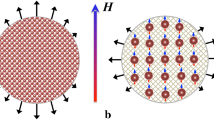Abstract
Magnetic elastomers represent a new type of materials that are “soft” matrices with “hard” magnetic granules embedded in them. The elastic forces of the matrix and the magnetic forces acting between granules are comparable in magnitude even under small deformations. As a result, these materials acquire a number of new properties; in particular, their mechanical and/or magnetic characteristics can depend strongly on the polymer matrix filling with magnetic particles and can change under the action of an external magnetic field, pressure, and temperature. To describe the properties of elastomers, we use a model in which the interaction of magnetic granules randomly arranged in space with one another is described in the dipole approximation by the distribution function of dipole fields, while their interaction with the matrix is described phenomenologically. A multitude of deformation, magnetic-field, and temperature effects that are described in this paper and are quite accessible to experimental observation arise within this model.
Similar content being viewed by others
References
G. Filipcsei, I. Csetneki, A. Szilágyi, and M. Zrínyi, Adv. Polym. Sci. 206, 137 (2007).
X. Guan, X. Dong, and J. Ou, J. Magn. Magn. Mater. 320, 158 (2008).
Yu. L. Raikher and O. V. Stolbov, Vychisl. Mekh. Splosh. Sred 2 (2), 85 (2009).
A. P. Safronov, T. V. Terziyan, A. S. Istomina, and I. V. Beketov, Polym. Sci. A 54, 26 (2012).
X. Zhang, S. Peng, W. Wen, and W. Li, Smart Mater. Struct. 17, 045001 (2008).
E. Z. Meilikhov, J. Exp. Theor. Phys. 97, 587 (2003).
J. D. Jackson, Classical Electrodynamics (Wiley, New York, 1999).
Ch. Kittel, Introduction to Solid State Physics (Wiley, New York, 1996, Nauka, Moscow, 1978).
S. Chandrasekhar, Rev. Mod. Phys. 15, 1 (1943).
H. Zhang and M. Widom, Phys. Rev. B 51, 8951 (1995).
L. D. Landau and E. M. Lifshitz, Course of Theoretical Physics, Vol. 7: Theory of Elasticity (Nauka, Moscow, 1982, Pergamon Press, New York, 1986).
H. Mueller, Phys. Rev. 47, 947 (1935).
H. Mueller, Phys. Rev. 50, 547 (1936).
J. M. Luttinger and L. Tisza, Phys. Rev. 70, 954 (1946).
O. Okay, in Hydrogel Sensors and Actuators, Vol. 6 of the Springer Series on Chemical Sensors and Biosensors (Springer, Berlin, 2009), p.1.
S. V. Vonsovskii, Magnetism (Nauka, Moscow, 1971, Wiley, New York, 1971).
E. Z. Meilikhov, JETP Lett. 69, 623 (1999).
E. Z. Meilikhov, Phys. Solid State 43, 1225 (2001).
Author information
Authors and Affiliations
Corresponding author
Additional information
Original Russian Text © E.Z. Meilikhov, R.M. Farzetdinova, 2016, published in Zhurnal Eksperimental’noi i Teoreticheskoi Fiziki, 2016, Vol. 149, No. 6, pp. 1198–1207.
Rights and permissions
About this article
Cite this article
Meilikhov, E.Z., Farzetdinova, R.M. Structural phase transitions in isotropic magnetic elastomers. J. Exp. Theor. Phys. 122, 1038–1046 (2016). https://doi.org/10.1134/S1063776116060170
Received:
Published:
Issue Date:
DOI: https://doi.org/10.1134/S1063776116060170




